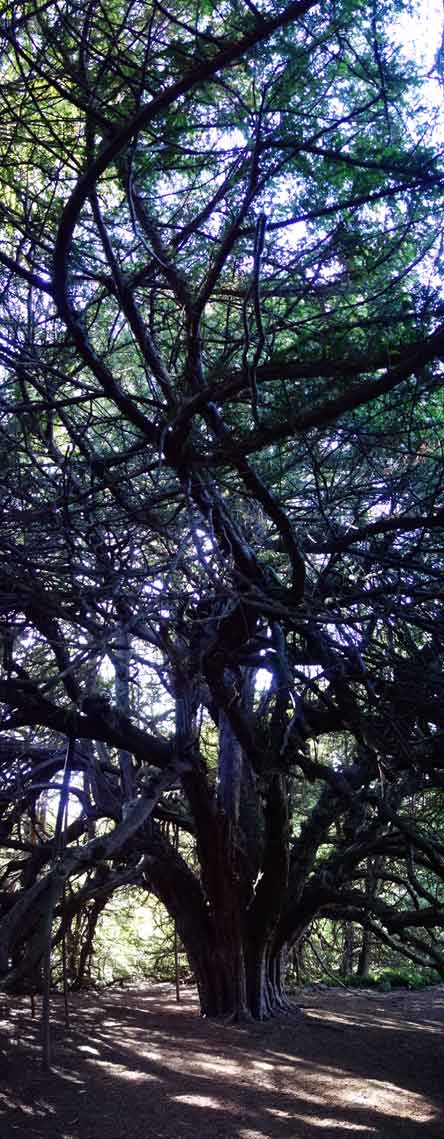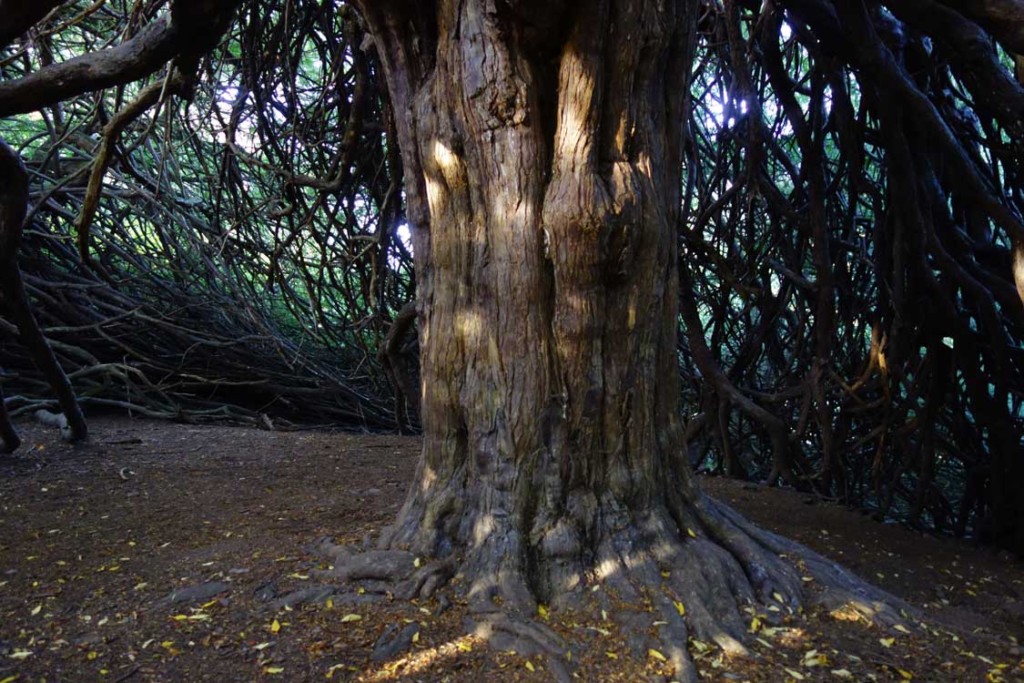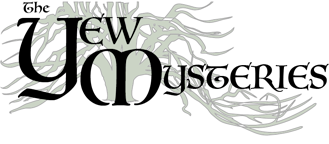Dedication
This website is dedicated to the yew tree as a living mystery. I was led into this mystery almost 25 years ago by a solitary and ancient female yew tree in Scotland that not only renewed my dying body, but also gave me the living template of a spiritual teaching I have named as the Yew Mysteries.

Ormiston Yew Tree
Yew - Tree of Eternity
The yew tree has survived virtually unchanged for over 250 million years as the oldest, and yet simultaneously the most youthful and even ‘embryonic’ tree species in Europe. I am using the adjective, 'embryonic' to describe the uncanny ability of the yew to continually renew itself. The oldest known word for the yew, eya (Hittite, circa 1750 BCE) means ‘eternity’ or ‘to be touched by eternity.’ To directly experience this force of ‘eternity’ and to learn how that force might be used to heal others is one of the greatest secrets of the Yew Mysteries. These mysteries are not of human invention. They represent the voice of a living organism whose ‘plant’ consciousness was awakened within the amniotic waters of the ancient Earth. By the time the Yew Mysteries were recorded by Greek historians around 500BCE they had already been revered and practiced by human beings for several thousands of years.
The Yew Mysteries, Atlantis & Human Migrations
During the post-diluvian era approximately 12,000 years ago, there were great migrations of peoples from the ‘shrinking’ trans - atlantic realm that is referred to as Atlantis. Some of these peoples traveled west to North America while others traveled east to India and Asia. However, many remained behind in the lands that eventually became known as Scotland, Ireland, Wales, England and Brittany, (Armorica.) It was in these areas that a great many of the ancient yew trees survived and consequently where the Yew Mysteries were best preserved. Based on this perspective, many of the native yew trees of the British Isles are of a vast age. The presumed Glacial Age that was introduced as an idea toward the end of the 19th century has led many botanists to assume that the yew must have made a gradual return to the British Isles and northern Europe between 7800 and 5000 BCE as the ice receded. However, many of these yew trees, although most likely subjected to the effects of extreme climate change and natural disasters, remained where they were. There is very little evidence of much glaciation in even north–east Siberia, considered to be the coldest land region on earth. The topography in southern Scotland is the same now as it was before being supposedly covered by thick sheets of ice, (Allan & Delair 1997.) The claim that there was a uniform Ice–Age has not been conclusively proven nor accepted with anything like the scientific consensus we are led to believe it has. Ultimately, we cannot determine the age of our oldest yew trees and until a scientific method emerges that can give an accurate date, we should allow the living 'gestures' of the trees themselves to provide 'good measure' in the balance of our opinions and beliefs about their age.
The peoples who remained behind alongside the ancient yews retained a deeply instinctual and almost dream-like consciousness that lived on and in accordance with the earliest forms of the Yew Mysteries. The ancient yews worked on the consciousness of these early yew initiates through the influence of lunar forces and beings, and in relationship to a primeval Saturn. We can well imagine, thousands of years later, the great mass movements of the peoples who had initially migrated to the east, slowly making their way back to their ancestral homelands where they would have found not only the original ancient yews, but the descendants of the peoples who had never left.
The Yew Mysteries & the Druids
The peoples returning from the east had developed a more earthly consciousness and brought a new kind of wisdom with them, a wisdom that was more intellectual and solar in nature - a Sun Wisdom. Gradually, and approximately between the third and second millennia BCE, the two wisdom streams merged to form what later became known as Druidism. It can therefore be said that the Druids were initiates of the Yew Mysteries. By 600CE the Roman Church had hijacked the wisdom teachings of the Druids, and the Yew Mysteries, (as one of the foundations of Druidism), were transferred retrospectively to Jesus the 'Nazarene' and to the story of the death and resurrection of Christ, the Sun King.
Keepers of the Yew Mysteries
The Yew Mysteries were known to the Greek Gnostics, and aspects of their initiatory structure were carefully studied in Alexandria until at least, and probably well beyond 400CE, ( Lash, 2006.) Key aspects of the Yew Mysteries were most certainly valued, even coveted, within the esoteric teachings of the Ionan and Irish Christians. Many saints and holy hermits native to the British Isles, such as St Columba are known to have had close associations with yews as well as with churches established on yew sites. However, any yew currently older than 1600 years has origins in a Pagan British Isles and is therefore considerably older than any church it may stand next to today or any saint it once met, (Greenwood 2016.) These saints and holy hermits may have sought to preserve key features of the mysteries by protecting the existing yews in their vicinity and by planting yew trees from 'holy' yew staffs. (There is no evidence in modern times of a yew staff having been successfully planted.) A handful of these saints established monastic colleges where it is likely that aspects of the Yew Mysteries continued to be transmitted 'behind closed doors' so to speak.' However, evidence is emerging of a counter stream, a resistance movement within the Yew Mysteries that sought to oppose the Christianization of its tenets and practices, (ongoing research by Greenwood & Dunning, 2016.) The Yew Mysteries were also preserved in some form in the famous School of Chartres that flourished during the eleventh and especially the first half of the 12th century. The Yew Mysteries were also well known to the Templars. A leading yew researcher, Paul Greenwood, has been able to establish many connections between the yew tree and the activities of the Knights Templar. One of these connections is revealed by the presence of an ornately carved 'yew pillar' (Apprentice Pillar) in the Templar built Rosslyn Chapel, Midlothian, Scotland. The current Earl of Rosslyn has indicated in print that the Apprentice Pillar may in fact be a representation of Yggdrasil. Nearby, and only several feet from Roslin Castle stands a mighty female yew. (There is an image of this magnificent yew, with Michael standing beneath, on the "About Michael Dunning" page of this website.) There is now upward of 30 years of research to suggest that the World Tree Yggdrasil was a yew and not an ash. The ash tree is neither evergreen nor is it long lived. Therefore it is highly likely that the so-called Apprentice Pillar is indeed a representation of the World Tree, Yggdrasil. Greenwood has also been able to determine that the Templars sought to bury their dead next to ancient yew trees. In fact, he has discovered evidence of modern Templar burials in Scotland taking place next to yew trees as late as 1972! The Yew Mysteries seem also to have been partially understood by the Rosicrucian Brotherhoods, although it appears today that the yew has lost much of its earlier significance to these groups. Many of the oldest and most powerful families in the United Kingdom own land where the most ancient yews are situated. This is no mere coincidence!
The Paradoxical Return of the Yew Mysteries
Today, the mysteries that were given by the sacred yew tree are returning to us in new and often paradoxical forms.
By the late 1960's the yew trees that had previously been ignored, destroyed or threatened were rediscovered and revalued as a potential cure for cancer. Wisdom that was known and cherished for thousands of years, that was given from a sacred and ‘eternal’ being, seemed to be finally returning to us. But the dominant form of the return of that wisdom was a partial realization, a compromise and denigration of meaning, bound to the biotech-pharmaceutical industry as a commodity, and very much at the expense of the continuing existence of many yew trees - India has lost 90% of its yews since 1992 because of the demand for taxanes, and the increase in yew plantations worldwide may create genetic pollution threatening the genetic diversity of the surviving native yew trees (Hageneder 2007) This is in no way meant to downplay the importance of Taxol/Paclitaxel to the many cancer survivors, many of whom have in fact been led to a deeper understanding and appreciation of the tree that has saved them. However, the deeper message and meaning of the sacred yew tree must be heard and appreciated in a wider context. It is no accident that many authorities now fully believe that the yew tree is indeed the World Tree, Yggdrasil. The message of the yew as given from the yew itself, inspires the return to our sacred origins and to the reinterpretation of a knowledge that was guarded and maintained long ago within the Yew Mysteries. The yew reunites us with the consciousness and sensory language of our origin in Spirit where we can be ‘touched by eternity’ and through that realize unlimited possibilities for transformation and healing. This is the essence of the Yew Mysteries that although centralized in the British Isles, resonated throughout the ancient world.
Look at many of the place names throughout the British Isles in particular, and you will see that the name of the yew is that place! Evidence for the once widespread veneration of the yew tree is there for all to see if they so wish it. Let us reclaim the yew and bring that veneration into the present.

Whittingehame Yew Tree
The Yew & Humanity
Today it is difficult for us to see the important role that the yew played in shaping the spiritual landscape of our earliest human history. Much of the ancient yew stands no longer exist and the yew trees that have survived are impossible to date accurately with any method known to modern science. The official story given for the decline of the yew concerns warfare and in particular the medieval arms trade that decimated the European yew well into 16th century. In truth the yew had been targeted for destruction much earlier to eradicate all evidence of the pre-Celtic pagan roots of Christianity. The yew has been described as "one of the most negatively affected European trees by human intervention" with the two main threats to the tree today coming from general deforestation and the hunt for taxanes, (Hageneder 2007.) During the 1970's in UK, a handful of people began to listen to, and even respond to the 'voice' of the endangered yew. Yew activism was born! One of these 'yew activists' is Janis Fry. She writes about, and has drawn attention to the ancient yew trees in Wales and in the south of Britain ( The God Tree, 2012.) Paul Greenwood, another 'yew activist' has been researching and writing about the ancient yew trees in northern England for over 30 years. He is a co-founder of the Ancient Yew Group (AYG) whose purpose is to identify, catalogue and protect our most ancient yews trees. The yew is now a protected species in a handful of countries, (sadly, not in the UK), but there is much more work to be done to raise greater awareness of the sacred as well as historic significance of the yew tree.
The yew tree is like a magic mirror to mankind. Historically, our treatment of it reflects the face of death or of life in the complexion of our beliefs and actions. During our earliest pre-history the mysteries of the yew both reflected and symbolized balance and continuity in the forces of pre-birth, birth, death and the afterlife. When our ancestors listened to its voice they were given the World Tree and the goddess archetypes, as well as sacred laws to live by and a ritual center for the original sacred marriage between the 'King' and the fertile land. In the Medieval period our ancestors chose to see their reflection as the face of death, and so the yew became valued entirely as a weapon of destruction in the form of the longbow. They virtually destroyed the World Tree in order to murder and dominate their own kind. For the last 500 years humanity largely abandoned the yew altogether. In 1960's, it was our turn to discover the yew and we stumbled again upon its life giving aspect, this time as a cure for cancer, and began mercilessly cutting down the old yews for their bark - taking us back to the face of death once again. Now there are yew plantations where the growth of the naturally slow - growing yew is accelerated so that the trees can be harvested in less time for their taxanes. This may adversely affect the old yew trees through the release of non-natural yew pollen. It is more than a mere coincidence that the yew has imprinted the consciousness of humanity with its own image at critical times in history. It has offered itself over and over again as a symbol of the deep and bleeding wound in the spirit of humanity that can yet heal. Over and over again the yew has sacrificed itself in order to teach us this one simple truth. Yet we do not listen, and now there are not enough yews left for another sacrifice. We are very fortunate that the earthly manifestation of the eternal principle of the Tree of Life continues to teach and inspire in the last few surviving ancient yew trees. These wise elders can still teach us this one simple truth: We have the ability to heal. We have the ability to choose to heal. We have the ability to choose to heal our world and ourselves. The yew has shown us that where there is poison there is also a cure. We have tasted enough poison.
The yew tree asks that you respect its physical space, and that above all you learn to trust in your ability to use your heart to reach out to it for guidance, no matter where you live on this beautiful planet.
